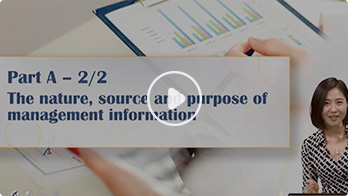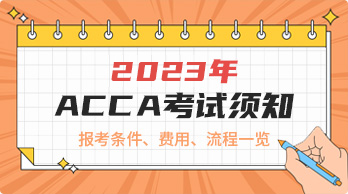
ACCA F2全称是Management Accounting,这一门课程是管理会计的内容,课程总体难度不大,差异分析的部分考试可能有些难度,另外一些财务比率的计算需要掌握,为今后的学习打好基础。以下是学员整理的一些ACCA考试科目F2学习笔记供新学员参考。ACCA题库,戳:ACCA题库【手机可刷+全球题库】(按照知识点进行分类配题,有知识点没有搞懂,无法解锁,直至掌握,目前阶段免费)
1.Target cost=target selling price–target profit=market price–desired profit margin.
2.cost gap=estimated cost–target cost.
3.TQM:
①preventing costs
②appraisal costs
③internal failure costs
④external failure cost
4.Alternative costing principle:
①ABC(activity based costing)
②Target costing
③Life cycle
④TQM
8.Time series:
①trend
②seasonal variation:⑴加法模型sum to zero;⑵乘法模型sum to 4
③cyclical variation
④random variation
9.pricipal budget factor关键预算因子:be limited the activities
10.budget purpose:
①communication
②coordination
③compel the plan
④motivative employees
⑤resource allocation
11.Budget committee的功能:①coordinated②administration
12.Budget:①function budget②master budget:1.P&L;2.B/S;3.Cash Flow
13.Fixed Budget:不是在于固不固定,而是基于一个业务量的考虑,financail expression.
Flexible Budget:包含了固定成本和变动成本,并且变动成本的变化是随着业务量的变化而改变。
14.Flexible Budget的优点:
①recognize different cost behavior.
②improve quality and a comparison of like with like
③help managers to forecast cost,revenue and profit.
15.Flexible Budget的缺点:
1假设太简单。
2需要更多的时间准备预算编制。
16.Controllable cost is a“cost which can be influenced by”its budget holder.大部分的变动成本是可控的,non-controllable cost为inflation.
17.Budget Behavior:
①participate approach
②imposed budget
18.payback投资回收期的缺点:
①ignore profitability
②the time value of money is ignored
③没有考虑项目后期带来的经济利益
④arbitray武断
19.payback投资回收期的优点:
①easy to calculate
②widely use
③minimize the effect of the risk and help liqidity
★如果在算投资回收期的时候,发生折旧,则需要加回折旧,因为折旧是非现金项目。
20.(1+real interst rate)*(1+inflation rate)=(1+nominal interest rate)
21.NPV=present value of future net cash flow–present value of initial cost
22.永续年金=A/i
23.每年的汇报是相同的就查看年金现值系数表,不同的就查看年金系数表。
24.EAR=CAR=APR=(1+r/n)n–1有效年利率
25.IRR:(based on cash flow analysis)
①IRR>cost of capital,NPV>0,worth taking
②IRR<cost of capital,NPV<0,not worthwhile.
26.ARR=average profit/average investment(ARR是基于profit)
Average investment=(initial investment–residual value)/2
27.type of standard:
①basic standard
②current standard
③ideal standard
④attainable standard
28.Variance
1.Material Variance
⑴total material variance=standard cost–actual cost
⑵material price variance=(standard price–actual price)*actual quantity
⑶material usage variance=(standard usage of actual output-actual usage)*standard price.
2.Direct Labor Variance
⑴standard pay–actual pay
⑵Labor rate variances=(standard rate–actual rate)*actual hrs of actual output
⑶Labor efficiency variances=(standard hrs of actual output–actual hrs)*standard rate
3.Variable production overhead variances
⑴Total variable O.H.variance=standard cost–actual cost
⑵Variable O.H.expenditure variance=(standard rate–actual rate)*actual hrs
⑶Variable O.H.efficiency variance=(standard hrs of actual output–actual hrs)*standard rate
4.Fixed O.H.expenditure variance
⑴Fixed O.H.Expenditure variance=budget expenditure–actual expenditure
⑵Fixed O.H.volume=(actual output-budgeted volume)*standard hrs per unit*standard rate per hr.
⑶Capacity variance=(actual hrs worked–budgeted hrs worked)*standard rate per hr
⑷Efficiency variance=(standard hrs worked for actual output–actual hrs worked)*standard rate per hr⑴+⑵:Fixed O.H.total variance=fixed O.H.absorbed–actual expenditure
5.Sales variance
⑴Sales price variances=(actual price–budget price)*actual sales units
⑵Sales volume variances=(actual sales units–budget sales units)*standard profit per unit
(absorption)
⑶Sales volume variances=(actual sales units–budget sales units)*standard CPU(marginal costing)
6.Idle time variances
Idle time variance=(expected idle time–actual idle time)*adjusted hr rate
29.The elements of a mission statement including:
①Purpose
②Strategy
③Policies and standards of behavior
④Values and culture
30.A critical success factor is a performance requirement that is fundamental to competitivesuccess.
31.Profitability ratios
①Return on capital employed(ROCE)
=profit before interest and tax/(shareholders’funds+long-term liabilities)×100%
②Return on equity(ROE)=profit after tax/shareholders’funds×100%
③Asset turnover=sales/capital employed×100%
=sales/(shareholders’funds+long-term liabilities)×100%
④Profit margin=profit before interest and tax/sales×100%
Profit margin×asset turnover=ROCE
32.Debt and gearing ratios
①Debt-to-equity ratio=long-term liabilities/total equity×100%
②Interest cover=PBIT/Interest×100%
33.Liquidity ratios
①Current ratio=current assets/current liabilities
②Quick ratio(acid test ratio)=current assets minus inventory/current liabilities
34.Working capital ratios
①Inventory days=average inventory*365/cost of sales
②Receivables days=average trade receivables*365/sales
③Payables days=average trade payables*365/cost of sales(or purchases)
35.Non-financial performance measures
Non-financial performance measures are considered to be leading indicators of financial performance.
①Market share
②Innovation
③Growth
④Productivity
⑤Quality
⑥Social aspects
36.The balanced scorecard:
①financial perspective②external perspective
③customer perspective④learning and innovation perspective
37.Benchmarking:
①Internal benchmarking
②Competitive benchmarking
③Functional benchmarking
④Strategic benchmarking
38.Value analysis is a planned,scientific approach to cost reduction,which reviews the material composition of a product and the product's design so that modifications and improvements can be made which do not reduce the value of the product to the customer or user.
39.Four aspects of'value'should be considered:
①Cost value
②Exchange value
③Utility value
④Esteem value
40.ROI=PBIT/capital employed*100%
Widely used and accepted;As a relative measure it enables comparisons to be made with divisions or companies of different sizes.
41.RI=PBIT-Imputed interest*capital employed.
Possible to use different rates of interest for different types of assets;Cost of finance is beingconsidered.ACCA题库,戳:ACCA题库【手机可刷+全球题库】(按照知识点进行分类配题,有知识点没有搞懂,无法解锁,直至掌握,目前阶段免费)




 考经分享
考经分享
 发布时间:2018-02-01
发布时间:2018-02-01 

 复制本文链接
复制本文链接 模拟题库
模拟题库

 194
194



















